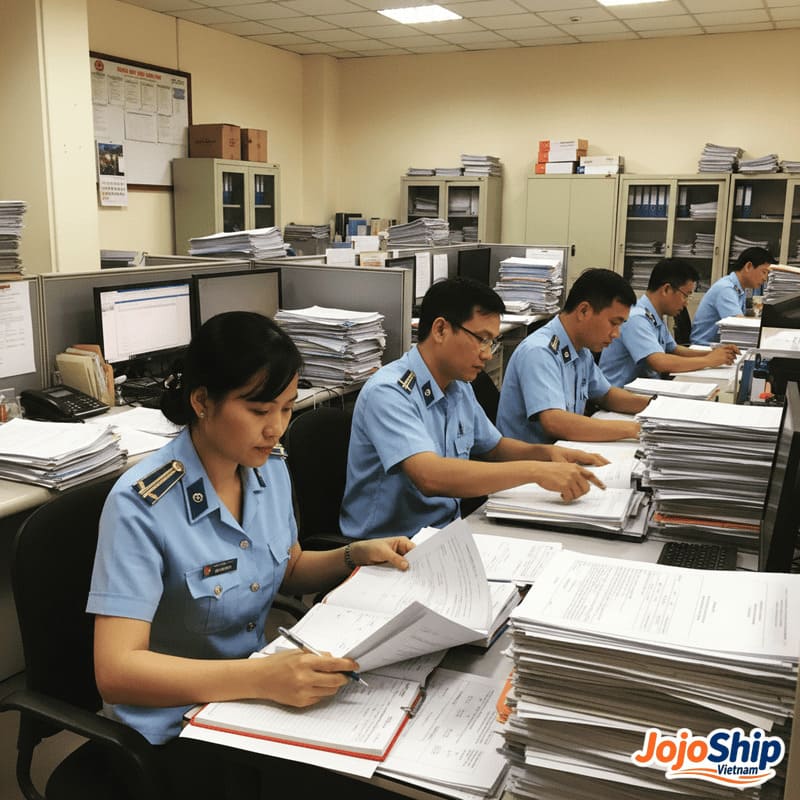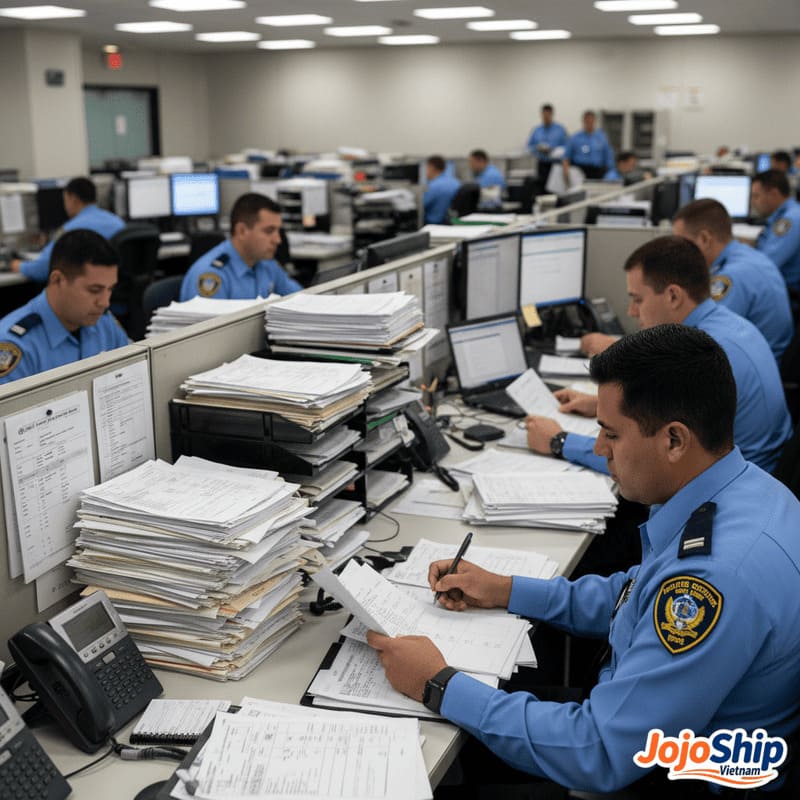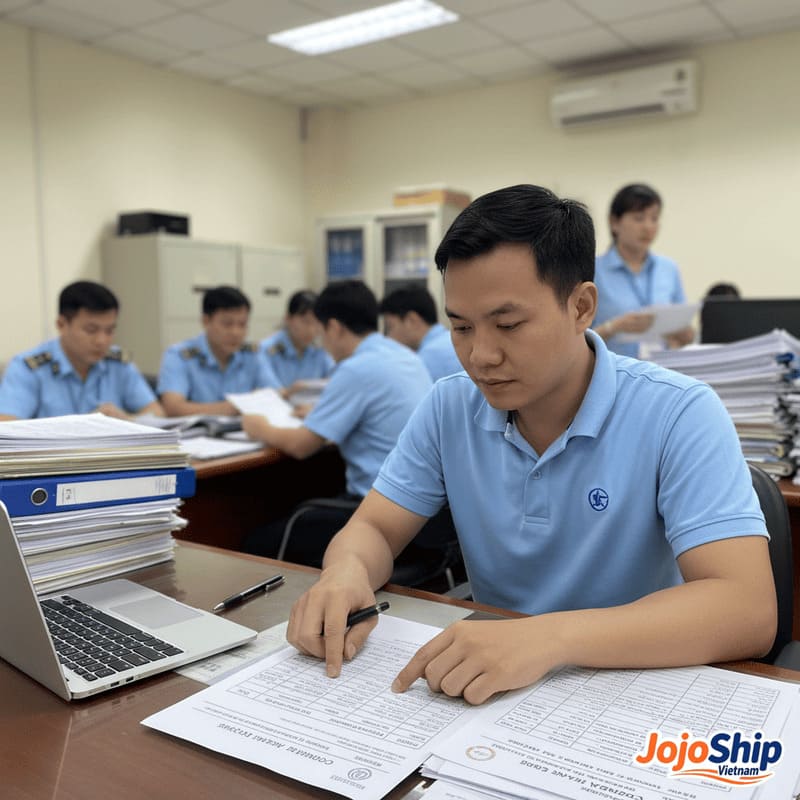Navigating Vietnam's complex customs regulations can lead to costly delays, compliance issues, and unexpected fees. Working with experienced customs brokers can mean the difference between smooth import operations and products stuck in customs limbo.
Companies providing customs clearance services for imports from Vietnam include VNT Logistics, USA Customs Clearance, JojoShip Vietnam, KMG, TOGHN/ILT, FasTrans, MBF Vietnam, and ELS Logistics. These firms offer expertise in documentation, tariff classification, duty calculation, and compliance with both Vietnamese and US customs regulations.

I still remember helping a client who tried to handle their own customs clearance for a shipment of furniture from Vietnam. Their goods were held at the port for over three weeks due to incorrect Harmonized System (HS) codes and missing certificates of origin. By the time they finally engaged a professional customs broker, they had incurred thousands in storage fees and missed their retail launch date. Let me share what I've learned about finding the right customs clearance partner for your Vietnam imports.
How Do I Get Customs Clearance in Vietnam?
Navigating Vietnam's customs system can be overwhelming with its unique procedures, documentation requirements, and frequent regulatory changes that catch many importers off guard.
To get customs clearance in Vietnam, you need to submit a customs declaration form, commercial invoice, packing list, bill of lading/airway bill, and potentially certificates of origin, inspection, or product-specific permits. Most importers hire a licensed Vietnamese customs broker to handle this process accurately and efficiently.

Step-by-Step Vietnam Customs Clearance Process
Understanding the customs clearance process in Vietnam helps you anticipate requirements and prepare properly. Having handled countless shipments through Vietnamese customs, I've compiled this detailed breakdown of the process and key considerations.
| Step | Description | Required Documents | Typical Timeframe | Key Considerations |
|---|---|---|---|---|
| 1. Pre-clearance Preparation | Gather and prepare all necessary documents | Commercial invoice, packing list, transport documents | 1-2 days before arrival | Ensure documents match exactly |
| 2. Customs Registration | Register with Vietnam customs system | Business license, tax code | One-time process | Often handled by broker |
| 3. HS Code Classification1 | Determine correct tariff codes | Product specifications, technical documents | 1-2 days | Critical for correct duty assessment |
| 4. E-Customs Declaration | Submit electronic declaration to customs system | Full documentation package | 1 day before arrival | System can be temperamental |
| 5. Document Verification | Customs examines submitted documents | Original versions may be required | 1-2 days | May require clarifications |
| 6. Physical Inspection (if selected) | Customs inspects cargo | Inspection notice | 1-3 days | Random or risk-based selection |
| 7. Duty and Tax Payment | Payment of all applicable fees | Customs assessment notice | 1 day | Must be paid before release |
| 8. Cargo Release | Final approval and release of goods | Release order | 1 day | Requires customs stamp |
When I first began coordinating shipments from Vietnam, I was surprised by how different their customs procedures were compared to other Asian countries. For example, Vietnam still requires original hard copies of many documents that other countries accept electronically. Working with a broker like TOGHN or MBF Vietnam saved us countless headaches because they understood these nuances.
The e-customs system in Vietnam (VNACCS/VCIS2) has streamlined many processes, but it still requires expertise to navigate correctly. When one of my clients tried to handle declarations themselves, they consistently had their submissions rejected due to minor technical errors. After switching to KMG's customs brokerage service, their clearance time dropped from an average of 5-7 days to just 2 days.
Special permits and licenses represent another common stumbling block. Vietnam requires specific permits for certain product categories like electronics, food products, and cosmetics. I once had a shipment of skincare products held for nearly a month because the importer wasn't aware they needed approval from Vietnam's Ministry of Health. Working with ELS Logistics could have prevented this issue as they specialize in obtaining these specialized permits.
Vietnam's customs authorities also conduct frequent physical inspections3, particularly for new importers or unusual shipment patterns. Licensed brokers like FasTrans or Saigon Worldwide Express have established relationships with customs officials and understand how to prepare your shipment for inspection, significantly reducing the risk of delays.
For businesses importing from Vietnam to the US, companies like JojoShip Vietnam offer end-to-end solutions that handle both Vietnam export clearance and US import clearance. This dual-sided approach eliminates coordination issues and ensures documentation is prepared correctly for both countries' requirements.
Are There Import Duties From Vietnam to the USA?
Understanding duty obligations is crucial for accurate landed cost calculations, but many importers are confused by the complex tariff schedules and trade agreements that affect Vietnam-US trade.
Yes, there are import duties for goods shipped from Vietnam to the USA, with rates varying by product type. Most goods fall under standard Most Favored Nation (MFN) rates, typically ranging from 0-25%. Unlike some countries, Vietnam does not have a comprehensive free trade agreement with the US that would eliminate these duties.

Understanding Import Duties for Vietnamese Products
Import duties can significantly impact your total landed costs when importing from Vietnam. Based on my experience managing various product categories, I've created this breakdown of typical duty scenarios and considerations.
| Product Category | Typical US Import Duty Rate | Special Considerations | Potential Exemptions | Documentation Needed |
|---|---|---|---|---|
| Apparel & Textiles | 16-32% | Subject to textile quotas in some cases | None currently available | Certificate of origin4 |
| Furniture | 0-4.7% | Material composition affects rate | Certain wooden items | Material breakdown |
| Electronics | 0-5% | FTA eligibility for components | Information Technology Agreement5 | Technical specifications |
| Footwear | 8-67.5% | Extremely variable by material | None currently available | Detailed product construction |
| Seafood | 0-15% | FDA inspection required6 | Certain farm-raised species | NOAA form, health certificates |
| Handicrafts | 0-6.6% | Classification challenges | Some traditional items | Artisanal certifications |
| Machinery | 0-5% | Parts vs. complete machines | Some industrial equipment | Technical documentation |
| Agricultural Products | 0-20% | USDA inspection, quotas possible | Some tropical products | Phytosanitary certificates |
Working with Vietnam exports for years, I've found that duty assessment can be very nuanced. For example, a client importing wooden furniture from Vietnam was paying 3.2% duty until we discovered that one specific product line qualified for duty-free treatment based on its construction method. The customs broker they had been using wasn't familiar enough with wooden furniture classifications to identify this opportunity.
Vietnam does not currently benefit from any comprehensive free trade agreement with the US, unlike some neighboring countries. This sometimes creates confusion among importers who assume all Asian countries have similar duty treatment. Companies like USA Customs Clearance and JojoShip Vietnam specialize in Vietnam-US trade and stay current on the specific duty treatments that apply to Vietnamese goods.
The Generalized System of Preferences (GSP) program7 occasionally covers certain Vietnamese products, but eligibility changes frequently. When working with VNT Logistics, they helped one of my clients identify when their decorative handicrafts temporarily qualified for GSP treatment, saving thousands in duties during that period.
Anti-dumping and countervailing duties represent a significant risk for certain products from Vietnam. For example, Vietnamese wooden bedroom furniture has faced anti-dumping duties reaching 200% in some cases. Customs brokers like Saigon Pacific Cargo and ALP Logistics Vietnam assist in proper product classification to ensure you're aware of any such special duties before importing.
The Harmonized System (HS) code assignment is perhaps the most critical factor in duty determination. I've seen identical products assigned different HS codes by different brokers, resulting in vastly different duty assessments. Working with specialists like KMG or MBF Vietnam who understand both Vietnamese export codes and US import codes ensures consistent and accurate classification.
Who Is Responsible for Import Customs Clearance?
Understanding clearance responsibilities prevents costly delays and confusion about who handles which aspects of the import process.
The party responsible for import customs clearance depends on your shipping terms (Incoterms). With DDP (Delivered Duty Paid) terms, the seller/exporter handles clearance. With DAP/DAT terms (Delivered at Place/Terminal), the buyer/importer is responsible. Most Vietnam-US shipments operate under FOB or EXW terms, making the importer responsible for clearance.

Clarifying Customs Clearance Responsibilities
Understanding exactly who handles each aspect of customs clearance is essential to prevent delays and ensure compliance. Based on my experience managing Vietnam-US trade, here's a comprehensive breakdown of responsibilities under different common scenarios.
| Scenario | Export Clearance | Import Clearance | Documentation | Duty Payment | Optimal Service Provider |
|---|---|---|---|---|---|
| FOB Terms | Vietnamese supplier/agent | US importer/broker | Shared responsibility | US importer | Separate brokers in each country |
| EXW Terms | US importer's agent in Vietnam | US importer/broker | US importer's responsibility | US importer | Integrated service like JojoShip Vietnam |
| DDP Terms | Vietnamese exporter's agent | Vietnamese exporter's US broker | Vietnamese exporter | Included in product price | Vietnamese forwarder with US network |
| CIF Terms | Vietnamese supplier/agent | US importer/broker | Vietnamese supplier provides core docs | US importer | Coordination between both parties |
| Using freight forwarder | Often included in service | May be additional service | Forwarder assists both sides | Typically importer | Full-service logistics provider |
| Self-filing (rare) | Requires Vietnamese agent | Direct with US CBP | Importer prepares all | US importer | Not recommended without experience |
The most common confusion I've encountered involves shipments on FOB terms (Free On Board)8, where many new importers mistakenly believe the supplier handles everything until arrival in the US. In reality, FOB only covers responsibilities until the goods are loaded on the vessel in Vietnam - everything after that, including US customs clearance, falls to the importer.
I recall a client who ordered machinery from Vietnam on FOB terms. When the shipment arrived in Los Angeles, they were shocked to discover they needed to arrange customs clearance themselves. The goods sat at the port accruing demurrage fees for over a week before they hastily engaged USA Customs Clearance to handle the entry. This expensive lesson could have been avoided with proper planning.
For businesses new to importing from Vietnam, I typically recommend working with a comprehensive service provider like JojoShip Vietnam or FNM Vietnam9 that handles both Vietnam export clearance and US import clearance. This integrated approach eliminates coordination problems between separate agents and ensures all documentation flows smoothly from one side to the other.
When using CIF terms (Cost, Insurance, and Freight)10, another common arrangement, the Vietnamese supplier handles transportation to the US port but not customs clearance. I've seen many importers caught off-guard by this distinction. Brokers like VNT Logistics often provide clear guidance on these responsibilities to prevent misunderstandings.
For companies importing regularly from Vietnam, establishing relationships with customs brokers in both countries11 offers the most control. Firms like TOGHN/ILT in Vietnam paired with a specialized US customs broker gives you experts on both sides of the transaction. This approach works well for larger importers with dedicated logistics teams who can manage the coordination.
How Much Is Custom Clearance in Vietnam?
Cost transparency is a common challenge when budgeting for imports, with many businesses encountering unexpected fees and charges12 that weren't included in initial quotes.
Customs clearance in Vietnam typically costs between $50-200 per shipment for standard goods, plus any applicable duties and taxes. This includes declaration fees, handling charges, and broker commissions. Complex shipments requiring special permits or inspections may cost $250-500 or more depending on the goods and service level.

Breaking Down Vietnam Customs Clearance Costs
Understanding the specific fees associated with customs clearance in Vietnam helps you budget accurately and identify potential cost savings. Based on my experience working with various customs brokers, here's a detailed breakdown of typical costs.
| Fee Type | Typical Cost Range | What It Covers | Variables Affecting Cost | Cost-Saving Tips |
|---|---|---|---|---|
| Basic Declaration Fee | $50-100 | Standard customs entry processing | Complexity of goods, broker | Bundle with freight forwarding |
| HS Code Classification13 | $15-30 per product | Product tariff classification | Number of unique products | Standardize product categories |
| Customs Inspection Fee14 | $80-150 | Physical inspection handling | Random selection probability | Maintain good compliance history |
| Special Permits/Licenses15 | $50-200 each | Product-specific approvals | Product category, requirements | Plan ahead for required permits |
| Document Preparation | $30-80 | Creating/reviewing documentation | Document complexity | Provide accurate information upfront |
| Customs Bond Fee | $40-100 | Financial guarantee for duties | Shipment value | Annual bonds for regular importers |
| Broker Service Fee | $50-150 | Overall handling and expertise | Service level, broker reputation | Negotiate volume discounts16 |
| After-Hours Processing | $80-150 | Expedited/weekend processing | Timing of shipment | Schedule during standard hours |
| Storage/Demurrage | $25-100/day | Holding goods during clearance | Clearance speed | Prepare documents in advance |
In my experience managing clearance for various products from Vietnam, I've found that the advertised base rates often don't tell the full story. For example, when importing electronics components with one broker, the quoted fee was $80, but additional charges for HS code verification, customs inspection handling, and document preparation brought the actual cost to over $200.
Transparency varies significantly among customs brokers in Vietnam. Companies like FasTrans and MBF Vietnam typically provide comprehensive quotes upfront that include all standard services. Others may quote a low base rate but add numerous surcharges later. When I worked with Minh Van Logistics, they provided a detailed fee schedule that clearly outlined every potential charge, which helped us budget accurately.
The complexity of your goods dramatically impacts clearance costs. When importing standard consumer products, basic clearance through ELS Logistics might cost around $100. However, when we imported specialized medical equipment that required Ministry of Health permits, the total clearance costs exceeded $450 due to the additional documentation and permit application handling.
Volume discounts are available but rarely advertised. After establishing a regular shipping pattern with Saigon Worldwide Express, we negotiated a 30% reduction in their standard clearance fees based on our monthly volume. Similarly, JojoShip Vietnam offers tiered pricing that automatically reduces clearance costs as your shipment frequency increases.
An often overlooked cost factor is the broker's familiarity with your specific product category. Specialists in certain industries can often process clearance more efficiently and at lower cost. For example, ALP Logistics Vietnam specializes in electronics and can typically clear these products faster and with fewer issues than general brokers, ultimately saving both time and money.
For businesses shipping from Vietnam to the US, integrated service providers17 that handle clearance in both countries often offer better value than using separate agents. Companies like JojoShip and VNT Logistics that manage both Vietnam export and US import clearance typically provide package rates that are more economical than the combined cost of separate brokers.
Conclusion
Companies providing customs clearance services for imports from Vietnam include VNT Logistics, JojoShip Vietnam, KMG, TOGHN/ILT, FasTrans, and MBF Vietnam. These providers offer expertise in documentation, HS code classification, permit applications, and duty calculation. Working with experienced customs brokers helps ensure compliance with both Vietnamese export regulations and US import requirements while minimizing delays and unexpected costs.
-
Correct HS Code classification ensures accurate duty assessment and prevents costly delays or penalties during customs clearance. ↩
-
Learning about VNACCS/VCIS helps you navigate Vietnam's electronic customs system efficiently and avoid common submission errors. ↩
-
Understanding physical inspections helps you prepare shipments properly and minimize the risk of delays or rejections. ↩
-
Learning about certificates of origin ensures your shipments meet US customs requirements and avoid unnecessary delays or penalties. ↩
-
Exploring the ITA can reveal potential duty exemptions for certain electronics, helping you save on import costs. ↩
-
Knowing FDA inspection rules helps you avoid shipment rejections and ensures compliance with US food safety standards. ↩
-
Understanding GSP eligibility can help you identify opportunities for reduced or eliminated duties on qualifying products. ↩
-
FOB terms are commonly misunderstood. Discover what responsibilities fall on each party and how to avoid costly mistakes in shipping. ↩
-
Integrated service providers simplify the import process and reduce risks. Find out how they can help streamline your Vietnam-US shipments. ↩
-
CIF terms often confuse importers about who handles customs clearance. Clarify your obligations to ensure smooth delivery of goods. ↩
-
Having customs brokers in both countries provides expert guidance and control over your shipments. Discover how this can benefit your business. ↩
-
Understanding hidden costs helps you avoid budget overruns and plan for all possible expenses during customs clearance. ↩
-
Learning about HS Code Classification helps you optimize product categorization and potentially reduce tariff and clearance costs. ↩
-
Minimizing inspection fees can save you money and speed up the clearance process for your shipments. ↩
-
Knowing permit requirements in advance helps you avoid costly delays and unexpected charges during customs clearance. ↩
-
Securing volume discounts can significantly lower your overall import costs, especially for regular shipments. ↩
-
Integrated providers can streamline the process and offer better package rates, saving you time and money on international shipments. ↩




